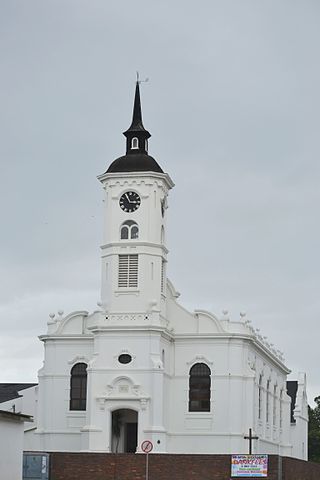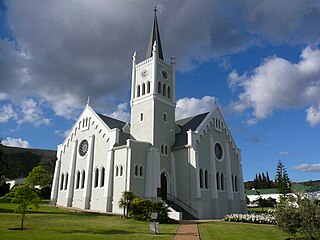The Reformed Churches in Namibia is a confessional Reformed church in Namibia. Reformed people come from Angola to Namibia in 1929. The Dorslandtrekkers were mostly Reformed people who had settled in Angola but later moved to Namibia. The Dorslandtrekkers were originally from Transvaal, South Africa, and migrated northwestward starting in 1874 in two large and one smaller group, starting the Humpata Reformed Church under the Rev. Jan Lion Cachet. Later in 1930 3 congregations were established. More farmers came and the church grew. Missionary work was started in 1969 under the Bushmans of the Gobabis region, Botswana. It has 2,757 members and 14 congregations, and adheres to the Apostles Creed, Nicene Creed, Heidelberg Catechism, Belgic Confession and the Canons of Dort.There's no women ordination. Official languages are Afrikaans, Bushman, Gobabis-Kung.

The Groote Kerk is a Dutch Reformed church in Cape Town, South Africa. The church is South Africa's oldest place of Christian worship. The first church on this land was built in 1678. Willem Adriaan van der Stel laid the cornerstone for the church. It was replaced by the present building in 1841 built by Herman Schuette and the original tower was retained. The pulpit is the work of Anton Anreith and the carpenter Jacob Graaff, and was inaugurated on 29 November 1789. The Groote Kerk lays claim to housing South Africa's largest church organ, which was installed in 1954
The Dutch Reformed Church Windhoek or NGK Windhoek is the oldest congregation of the Dutch Reformed Church in South Africa (NGK) in Windhoek the capital of Namibia.
The Gobabis Reformed Church is a congregation of the Dutch Reformed Church in South Africa (NGK) in Gobabis in eastern Namibia. In 1961, the Gobabis-South daughter congregation was founded, which was reincorporated into the mother church on October 21, 2012, making Gobabis the seventh city in Namibia to have two NGK congregations.
The Keetmanshoop Reformed Church is a congregation of the Dutch Reformed Church in South Africa (NGK) in southern Namibia. It is the third oldest NGK congregation in the country after Mariental and Otjiwarongo. Up until the founding of the Keetmanshoop congregation, the entire area known then as South West Africa (SWA) was divided between the two mother churches.
The Leonardville Reformed Church is a congregation of the Dutch Reformed Church in South Africa (NGK) in the town of Leonardville, Namibia.
The Mariental Reformed Church is the oldest congregation of the Dutch Reformed Church in South Africa (NGK) in Namibia and was founded in 1898 as the Gibeon Reformed Church.
The Omaruru Reformed Church is a congregation of the Dutch Reformed Church in South Africa (NGK) in the town of Omaruru, Namibia. It is the oldest daughter church of the Otjiwarongo Reformed Church (NGK), from whence all the NGK congregations north and west of Windhoek, capital of Namibia, directly or indirectly descend. Omaruru separated from Otjiwarongo on March 1, 1941, and services were held in Omaruru, Karibib, Usakos, Swakopmund, Walvis Bay, and Kalkfeld. Still large and difficult to serve, the Omaruru congregation let the Usakos Reformed Church (NGK) go in 1946.
The Outjo Reformed Church is a congregation of the Dutch Reformed Church in South Africa (NGK) in northwestern Namibia.
The Usakos Reformed Church is a congregation of the Dutch Reformed Church in South Africa (NGK) in Namibia, established in 1946 and serving as the mother church to all five congregations of the Namibian coast, except for the Lüderitz Reformed Church (NGK).

The Peperbus is an unusual, hexagonal building on Meyburgh Street, Fraserburg, in the Karoo of South Africa. Along with the Old Parsonage Museum and the Afrikaner Protestant church, earlier an Anglican church designed by Sophy Gray, the Peperbus is one of three national heritage sites the province maintains in the town.

The Johannesburg Reformed Church was the first congregation of the Dutch Reformed Church in South Africa (NGK) to be founded in Johannesburg on August 14, 1887. All the congregations on the Witwatersrand stem from it, but by the 2010s, the NGK yearbook recorded only 90 in its ward which had long ceased to operate independently.
The Johannesburg North Reformed Church/Andrew Murray Congregation is a bilingual congregation of the Dutch Reformed Church in South Africa (NGK) in the Johannesburg suburb of Orchards. It was formed in 1999 by the merger of the NGK congregation and the Andrew Murray Congregation and functions as a church without borders.
The Johannesburg East Reformed Church was a congregation of the Dutch Reformed Church in South Africa (NGK) in the Johannesburg suburb of Doornfontein, just east of downtown. It is also known as the Irene Church after the sobriquet of its second and third churches on 1 Beit Street. Five weeks before its centennial, on June 1, 1997, Johannesburg East was absorbed by the Johannesburg Reformed Church (NGK), from whence it had seceded on July 8, 1897.

The Langlaagte Reformed Church was the 28th congregation of the Dutch Reformed Church in South Africa (NGK) on the Transvaal and the second in Johannesburg after the Johannesburg Reformed Church (NGK) (1887). The congregation is well known as the spiritual home of the Langlaagte orphanage, later named the Abraham Kriel Children’s Home after Rev. Abraham Kriel, who founded it as pastor of Langlaagte.
The Linden Reformed Church was a congregation of the Dutch Reformed Church in South Africa (NGK) in the northwestern Johannesburg suburb of Linden. On July 1, 2018, it merged with the Aasvoëlkop Reformed Church to form the Aan die Berg Reformed Church.
The Bronberg Reformed Church was one of the largest congregations in the Dutch Reformed Church in South Africa (NGK), not only in the Pretoria area but nationwide. After the massive demographic changes of the 1990s in central Pretoria, the Bronberg, Arcadia (which had earlier absorbed Meintjieskop, Burgers Park, and Harmonie congregations were all absorbed by the Pretoria Reformed Church.

The Potchefstroom Reformed Church (in Potchefstroom, North West, South Africa, is the oldest congregation of the Dutch Reformed Church in South Africa in what was then the Transvaal or South African Republic. At its founding in March 1842, it was the 28th congregation in what would later become South Africa and the tenth outside of the Western and Southern Cape Synod.

The Dutch Reformed Church is a place of worship of the Dutch Reformed Church in Alexandria, South Africa. It was declared a Provincial Heritage Site in 1987.

The Dutch Reformed Church in Barrydale is a congregation of the Dutch Reformed Church centered on the village of Barrydale in the picturesque surroundings of the Langeberg on the R62, 62.5 km (38.8 mi) south-east of Montagu, 76 km (47 mi) south-west of Ladismith and more or less equidistant through the Tradouw Pass from Swellendam and Heidelberg. In 2014, the congregation had 49 baptized and 211 professing members. In that year the pastor was Rev. W. J. van Zyl.






